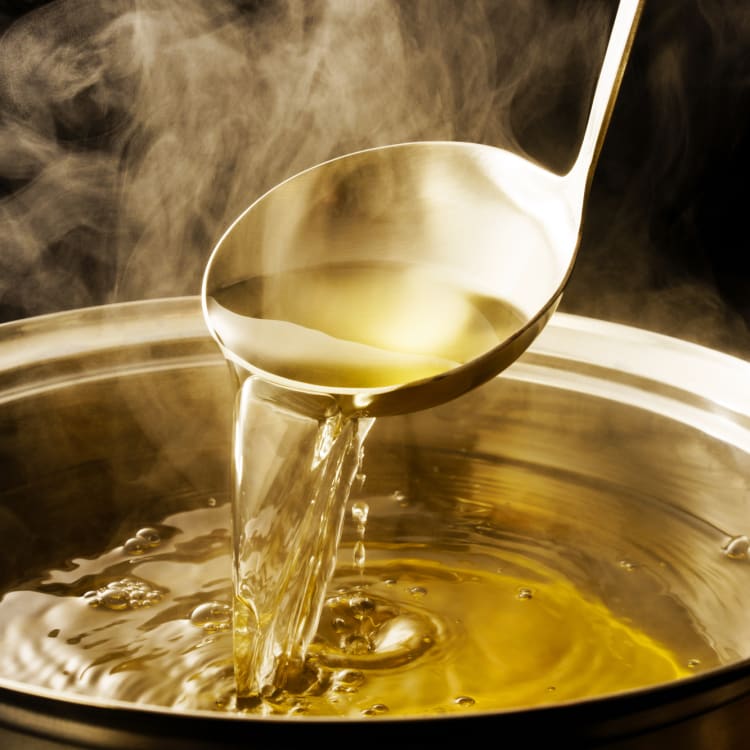
Story
Celebrating the fifth flavour
The heart of Japanese cuisine
JNTO on 22 November 2021
You may be familiar with “umami,” which translates roughly to “delectable” – specifically, the savoury flavour that lingers on your tongue that makes certain foods irresistible. In Japan, umami is synonymous with dashi, which is broth or stock at the heart of the Japanese cuisine, or washoku. This clear and unassuming broth is an umami-packed powerhouse that adds depth to any dish, from the home-cooked to even fine dining. Unlike Western broth which may take hours to prepare, dashi is built on just one or two ingredients which are only soaked in water or heated briefly.
Dashi may be simple to make, but the success of a Japanese dish often lies in the flavour of the broth because it enhances and harmonises the flavours of other ingredients, making the principle of washoku. It is often said that the highest compliment a chef can receive is “Dashi ga kiiteru!” which means that diners can taste its flavours.


Types of dashi
Dashi comes in numerous varieties changing from region to region. The simplest dashi is vegan, which can be made from kombu (a type of kelp) that is soaked in either cold or hot water, or from dried shiitake mushrooms which are soaked in warm water. There is also the stronger iriko dashi, or niboshi dashi, made with baby dried sardines or anchovies, which is more common in the Kanto region with bolder flavours.


The most common is the awase dashi, which is made with katsuobushi (bonito flakes) and kombu, and imparts a delicate flavour. Katsuobushi is made from bonito (a cousin of tuna), and the process includes drying out the fish, fermenting, and shaving it into flakes. Most people retain the leftover ingredients to make a second round of stock, referred to as niban dashi, which has a more intense flavour.
Kombu and katsuobushi are the two most popular dashi ingredients, and some regions in Japan are known for their production.

Hokkaido is Japan’s major kombu-producing region, and the prefecture’s coastline is home to a dozen varieties of seaweed. Kombu is harvested in summer – head to a beach in the mornings between July and October and you can watch crews hauling kombu into their boats or see kombu sun-drying in a hoshiba (drying area).


Bonito can be found in waters all around Japan, but locations with the largest production of katsuobushi are in the city of Makurazaki in Kagoshima prefecture and Shizuoka prefecture’s Yaizu port. Established in 1887, Yamaju Masuda Shoten is a small factory situated near Yaizu port, and offers factory tours. At their store, local products are up for grabs, or visits during their Tebiya Marche fair (held 4 times a year), where you can find katsuobushi and other local specialties.


Roots of dashi and their role in flavour
The Japanese have been using the boiling method for food since the Jomon period (13,000-300 BC), which is considered to be the starting point for dashi. Over time, the stock began to appear in written documents from the 4th century.
It wasn’t until 1908 that Dr. Kikunae Ikeda of Tokyo Imperial University discovered a taste in kombu dashi that couldn’t be described as any of the four major flavours namely sweet, salty, bitter, or sour. This source was identified as glutamate, which he named “umami” – in the 1980s, the term was widely accepted as the fifth taste.

Kombu has the highest natural levels of glutamate of any foodstuff in the world, while katsuobushi and niboshi contain high levels of inosinate, and dried shiitake mushrooms of guanylate. When umami is present in food, the flavour is not just added, but amplified. Therefore, cooking with umami-rich broths creates deep, complex flavours and reduces the need for the addition of salt or fat.
Cooking with umami
There are many traditional and modern washoku dishes you can try cooking using umami principles. From an elaborate osechi, a special kind of bento box for the new year packed with a myriad of delicacies, to ramen and stir-fries, every dish is enhanced with the presence of umami.


In recognition of its role of incorporating umami and dashi, washoku is now on the UNESCO list of intangible cultural heritage of humanity. To ensure those skills and knowledge, including the preparation and use of dashi, are preserved, the Japanese government has designated November 24 “Washoku Day.”
If you don’t have time or resources to make your own dashi, the easiest way to add a bit of umami is to sprinkle a dash of AJI-NO-MOTO, the world’s first umami seasoning launched in 1909. For washoku recipes using AJI-NO-MOTO, check out the official website.
















































